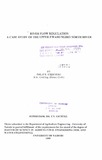| dc.contributor.author | Gichuki, P G | |
| dc.date.accessioned | 2013-05-10T12:23:58Z | |
| dc.date.available | 2013-05-10T12:23:58Z | |
| dc.date.issued | 1999 | |
| dc.identifier.citation | Gichuki, P. E(1999). River flow regulation :a case study of the upper Ewaso Ngiro North Rive | en |
| dc.identifier.uri | http://erepository.uonbi.ac.ke:8080/xmlui/handle/123456789/21375 | |
| dc.description | Msc- Thesis | en |
| dc.description.abstract | Water shortage during dry season and very high flows during wet seasons has been
identified as the major challenges in water resources management in Ewaso Ngiro North
River Basin, Kenya (ENNRB). The increasing water demand of the growing population,
unequitable allocation of water resources and the uneven distribution of dry weather river
discharges lead to tension and conflicts over the water resources in the basin. This study
has investigated the feasibility of developing proposed Archers Post and Kihoto reservoirs
to mitigate this problem of water shortage. The regulation of outflow from these reservoirs
should be such that the downstream water users are assured of certain quantity of flow in
the year round while the upstream water users are able to use the dry season river flow to
meet their irrigation water requirements.
The study objectives were to determine suitable reservoir sizes for the two sites and assess
the performance of the reservoir in augmenting low flows. This was done through
simulation of reservoir operations using Interactive River-Aquifer Simulation (IRAS)
modelfor reservoirs with active storage capacity ranging from 50-million m3 to one with
350-million m3 at an interval of 50-million m3 for each site. The criterion of selecting the
suitable reservoir size was based on the quantity of water that was made available by the
reservoir during low flow periods over the simulation period which was 27 years (1960-
1986). If the resultant increase in volume of water made available by an increase in
reservoir capacity was less than "15% of the volume of water made available by the
preceding reservoir active storage capacity the increase was considered unsuitable. The
next small reservoir size was considered the suitable reservoir capacity of the site. The
assessment of reservoir performance of the selected reservoir sizes was done using low
flow frequency analysis and the ability of the reservoir outflow to meet target releases.
The reservoir size that was selected for the proposed Archers Post site has a gross capacity
of 400-million rrr' while the one for Kihoto site has a gross capacity of 161-million rrr'. The
dead storage for the Archers Post reservoir is 200-million m3 with useful life span of 80
years and for Kihoto reservoir is II-million rrr' with a life span of 100 years if the current
sediment load conditions at the two sites prevail in future.
The reservoir operating policy used to simulate reservoir releases allowed the releases such
that the available water in the reservoir was adequate for 14 weeks. With this operating
policy the two reservoirs did not run dry at any time of simulation. It was found that with
this operating policy the Archers Post reservoir made available 3,001. 4-million m3 of water
in the low flow periods during the 27 years of simulation while 897.25-million m3 of water
was made available by Kihoto reservoir over the same period. This water, that was made
available by these reservoirs, has improved flow reliability together with the return period
of low flow events, which are shown to have a marked improvement at the two sites.
This study is expected to be an important contribution to the management of water
resources of ENNR, which Ewaso Ngiro North Development Authority (ENNDA) has
identified as strategic resource for the development of the area under its jurisdiction. One
way ENNDA can use results of this study will be to build on it to identify the water
demand that is required to boost the economy of the region and can be satisfied by the
outflows of these reservoir at a known reliability. It is also expected that based on the
findings of this study ENNDA will now carry-out detailed economic analysis of these
reservoirs to justify their development on the economic point of view. | en |
| dc.description.sponsorship | University of Nairobi | en |
| dc.language.iso | en | en |
| dc.subject | River flow | en |
| dc.subject | Regulation | en |
| dc.subject | Upper Ewaso Ngiro North River | en |
| dc.title | River flow regulation :a case study of the upper Ewaso Ngiro North River | en |
| dc.type | Thesis | en |
| local.publisher | Department of Agricultural Engineering, University of Nairobi | en |

